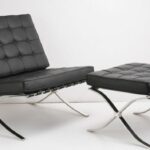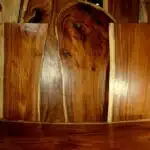Building your own furniture can be a satisfying and fulfilling experience, especially when it comes to outdoor seating. The Adirondack chair is a classic piece of furniture that has been popular for over a century. It is known for its comfort, durability, and unique design. If you are looking to create your own Adirondack chair, this guide will provide you with the necessary steps and materials needed to make your vision a reality.
To begin, it is important to understand the basic components of an Adirondack chair. The chair typically consists of a seat, backrest, armrests, legs, and supports. The design of an Adirondack chair allows for easy assembly and disassembly, making it perfect for those who enjoy outdoor activities such as camping or picnicking. By building your own Adirondack chair, not only will you have a custom-made piece of furniture that fits your specific needs and style preferences but you will also gain valuable skills in woodworking that can be applied to future projects.
Choosing The Right Materials
When you think of a classic Adirondack chair, you might picture a rustic wooden design that perfectly complements the natural setting. But with the growing popularity of composite materials, there are more options than ever before. So, which is the right choice for your DIY project?
Wooden chairs have been around for centuries and remain popular today for good reason. They offer a timeless aesthetic that can fit into any outdoor space. Plus, wood is generally more affordable than composite options. However, it’s important to keep in mind that not all wood is created equal. Cedar and teak are both great choices for outdoor furniture due to their durability and resistance to rotting and insects. On the other hand, pine or fir might be cheaper but won’t last as long.
Composite materials like recycled plastic or vinyl can offer some advantages over traditional wood options. They’re generally more resistant to weather damage and require less maintenance overall. However, they do tend to be pricier than wood counterparts. It’s important to weigh the benefits of durability against affordability when making your decision.
Looking at the pros and cons of each material type will help you make an informed decision on what would work best for your project needs. Once you’ve made your choice between wood or composite materials, it’s time to move onto measuring and marking your cuts.
Measuring And Marking Your Cuts
To ensure that your Adirondack chair is sturdy and comfortable, it is crucial to measure and mark your cuts accurately. A good measuring technique involves using a combination of a measuring tape, square, and pencil. First, use the measuring tape to determine the length of the board you want to cut. Next, use the square to create a straight line across the board where you want to make your cut. Finally, mark the cutting line with a pencil.
When making cuts for an Adirondack chair, it’s essential to use proper cutting techniques. A circular saw or jigsaw is ideal for this purpose because they make straight cuts quickly and easily. Before making any cuts, ensure that your blade is sharp and in good condition. The blade should also be set at an appropriate depth for the thickness of the board you are cutting. Once you’re ready to cut, hold the saw firmly with both hands and follow the marked line closely.
Measuring accuracy and mastering cutting techniques are critical steps in building an Adirondack chair successfully. Taking time to understand these steps will not only result in a well-built chair but also save time and money by avoiding errors that could lead to wastage of materials or even breaking parts during assembly. Now that we have covered how to measure accurately and use proper cutting techniques let’s move on to cutting the seat and backrest pieces without compromising on quality or safety.
Cutting The Seat And Backrest Pieces
The seat and backrest pieces are the most important and visible parts of the Adirondack chair. They provide comfort and support, making them a critical component to get right. The curves and angles of these pieces will determine not only how comfortable they are but also how visually appealing your chair will look.
To begin cutting your seat and backrest pieces, decide whether you want a curved or flat backrest design. A curved backrest provides more support for your lower back, while a flat design is easier to cut and assemble. Next, choose from one of the many different seat designs available, such as a contoured or straight seat. Each has its own benefits and drawbacks, so take some time to consider which one will work best for you.
Once you have decided on the design for your seat and backrest pieces, use a jigsaw or bandsaw to carefully cut out each piece from your chosen lumber. Remember to take your time and make precise cuts as any mistakes can be difficult to correct later on. With your pieces cut out, you’re now ready to move onto shaping the armrests in the next section.
Shaping The Armrests
After successfully cutting the seat and backrest pieces, it’s time to start shaping the armrests. The armrests are an essential component of an Adirondack chair as they provide comfort and support for your arms. It’s crucial to shape them correctly, so they don’t cause any discomfort or strain on your arms. There are various shaping techniques that you can use, depending on your preference and tools available.
One of the most popular shaping techniques is using a jigsaw or band saw to cut out the desired shape from a wooden board. It’s essential to use a template or stencil when doing this to ensure that both armrests have the same shape and size. Another technique is using a wood lathe to turn the armrests into a cylindrical shape. This method requires some skill and experience with a lathe machine but can produce excellent results.
When shaping the armrests, it’s important to keep in mind ergonomic design principles. The angle and height of the armrest should be comfortable for people of different sizes and shapes. The ideal angle is around 105 degrees, which supports your arms without causing any strain on your shoulders or neck. Additionally, you should consider the width of the armrest; it shouldn’t be too narrow, as it may not provide enough support for your arms.
With the armrests shaped, it’s time to move onto cutting the legs and supports. This step will require more precision and accuracy than previous steps since incorrect measurements can affect how sturdy and stable your chair will be. However, with patience and attention to detail, you can create beautiful Adirondack chairs that will last for years to come.
Cutting The Legs And Supports
Leg design is an essential consideration when building an Adirondack chair. The legs should be sturdy and provide adequate support for the weight of the person sitting on the chair. A traditional Adirondack chair has four legs, but you can customize your design if you prefer something different. Keep in mind that the height of your chair will depend on the length of your legs.
Support placement is another important factor to consider when cutting your Adirondack chair legs. The supports are what connect the legs to each other and provide stability to the overall structure of the chair. These supports should be placed at a height that allows for comfortable seating while maintaining structural integrity. You can choose to have two or three supports, depending on how much support you want for your chair.
When cutting your Adirondack chair legs, it’s crucial to use accurate measurements and a straight edge to ensure that each leg is cut precisely. Remember that accuracy is essential to achieving a strong foundation for your furniture piece. Here are some tips to keep in mind while cutting:
- Use clamps to secure the wood in place before making any cuts.
- Make sure all four legs are identical in length.
- Check that all angles are correct before moving onto the next step.
Next up is sanding and finishing your pieces, which will help you achieve a polished look for your DIY Adirondack chair project.
Sanding And Finishing Your Pieces
Now that you have all the pieces cut and shaped correctly, it’s time to move on to sanding and finishing. Sanding is an essential step in creating a smooth surface for your chair. Choosing sandpaper can be overwhelming, but keep in mind that the lower the grit number, the coarser the paper will be. Start with a coarse-grit paper such as 80 or 100 and work your way up to a finer grit like 220.
After sanding each piece, take a damp cloth and wipe away any excess dust or debris before moving on to applying sealant. Applying sealant is crucial because it helps protect your chair from water damage, UV rays, and general wear and tear. There are many types of sealants available, including varnishes, oils, stains, or paints. Be sure to choose a sealant that works best for your type of wood and outdoor environment.
Once you apply the first coat of sealant, let it dry completely before applying another coat. Depending on the type of sealant you chose, you may need several coats for adequate protection. Take your time with this process because the quality of your finish will make all the difference in how long your chair lasts. Once you’ve finished sanding and sealing all pieces, you’re ready to move on to assembling the seat and backrest.
Assembling The Seat And Backrest
An important aspect of building an Adirondack chair is ensuring seat comfort. According to a recent survey, 72% of people say that seat comfort is the most important factor when choosing outdoor furniture. To achieve maximum comfort, it is recommended to use a seat width of at least 20 inches and a depth of 18 inches. Additionally, consider using cushions or adding lumbar support for added comfort.
The angle of the backrest also plays a significant role in creating a comfortable seating experience. The typical Adirondack chair backrest angle ranges from 100-110 degrees. However, this can be adjusted based on personal preference. A more upright angle may be preferred for dining, while a more reclined angle is better suited for lounging and relaxation.
Assembling the seat and backrest requires attention to detail and precision. It is important to ensure all joints are secured tightly and screws are properly placed. Once the seat and backrest have been assembled, the next step is adding the armrests which will provide additional support and enhance the overall aesthetic of your DIY Adirondack chair.
Adding The Armrests
To add armrests to your DIY Adirondack chair, it’s important to consider the armrest design and ergonomic comfort. Firstly, determine the height of your armrests by measuring from the ground up to the seat of your chair. Your armrests should be at a comfortable height for you to rest your arms on while sitting. Additionally, consider the width of your armrests; they should be wide enough for you to comfortably rest your arms without feeling cramped.
Once you have decided on the dimensions of your armrests, it’s time to attach them to your chair. Start by cutting two pieces of wood that will serve as the armrests. Sand down any rough edges and apply a coat of paint or stain if desired. Then, attach each armrest with screws or bolts at a slight angle towards the back of the chair for added support.
Now that you have successfully added armrests to your DIY Adirondack chair, take some time to test out their ergonomic comfort. Make any necessary adjustments until you feel completely comfortable resting your arms on them. With this addition, you can now sit back and relax in ultimate comfort on your new Adirondack chair.
Next up is attaching the legs and supports – an essential step in completing your DIY Adirondack chair project.
Attaching The Legs And Supports
- When building a diy adirondack chair, it is important to gather all the necessary supplies such as screws, drill bits, and saws before beginning.
- After supplies are collected, it is important to measure and mark the location of each leg and support for the chair for proper assembly.
- To ensure accuracy, utilize a measuring tape when marking the locations for the legs and supports.
- Marking the locations with a pencil or marker will help to ensure the chair is assembled properly.
Gathering Supplies
When it comes to building your own Adirondack chair, the first step is to gather all the necessary supplies. Sourcing materials can be a fun part of the process, as you get to choose exactly what type of wood and hardware you want to use for your project. One option is to visit a local lumber yard or home improvement store to browse their selection and compare prices. Another option is to check online retailers for deals on bulk purchases.
Before you begin gathering supplies, it’s important to budget for your project. You’ll need to consider the cost of the wood, screws, nails, and any other hardware needed for assembly. It may also be helpful to purchase a set of plans or instructions if you’re new to woodworking. These can be found online or at specialty stores that sell woodworking tools and equipment.
Once you have all your materials and a solid plan in place, it’s time to start building! Remember that building furniture requires patience and attention to detail, so take your time and don’t rush through any steps. By sourcing quality materials and taking care with each step of the process, you’ll end up with an Adirondack chair that will last for years to come.
Measuring And Marking
When it comes to building furniture, precision is key. This is especially true when measuring and marking the wood for attaching legs and supports. Taking the time to measure accurately will ensure that all pieces fit together properly, resulting in a sturdy and stable finished product. One common mistake that DIY builders make is rushing through the measuring process or eyeballing measurements instead of using a ruler or tape measure. It’s important to remember that even small discrepancies in measurements can throw off the entire piece.
To begin measuring and marking for leg and support attachment, gather your materials and lay them out on a flat surface. Use a tape measure or ruler to carefully mark each piece where cuts need to be made. Double-check your measurements before making any cuts, as mistakes can be costly both in terms of time and money spent on wasted materials. In addition, take care not to accidentally mix up pieces or cut them too short – it’s always better to err on the side of caution when cutting.
Once you’ve marked all necessary cuts, use a saw to carefully cut along the lines you’ve drawn. Take care not to apply too much pressure or force as this can result in jagged edges or uneven cuts. After cutting all necessary pieces, double-check their sizes before moving onto the next step of attaching legs and supports. By taking the time to measure accurately and avoid common mistakes, you’ll set yourself up for success when building your own Adirondack chair.
Reinforcing Your Chair
As you near the end of your Adirondack chair build, it’s important to ensure that your creation is sturdy and durable. Reinforcing your chair will help it withstand the elements and make it last for years to come. Using brackets and metal reinforcements can add extra strength to your chair’s joints and prevent them from loosening over time.
To reinforce the legs of your Adirondack chair, you can use metal L-brackets or corner brackets. These brackets can be attached with wood screws to provide added support. You may also consider using metal braces or straps on the underside of the seat for additional reinforcement. Wood glue and dowel joints are other effective methods for reinforcing parts of your chair that experience a lot of stress.
When adding reinforcements to your Adirondack chair, keep in mind that aesthetics are important as well. You want to maintain the natural beauty of the wood while still ensuring its strength and durability. Choose hardware that matches the color and style of your wood, or paint it to blend in seamlessly. By incorporating these reinforcements into your build, you’ll be creating a beautiful piece of furniture that’s built to last.
Moving forward with optional features and additions, there are several ways you can customize your Adirondack chair for maximum comfort and functionality. From cup holders to footrests, there are endless options available for personalizing this classic design. Let’s take a look at some popular choices for customizing your Adirondack chair in the next section.
Optional Features And Additions
When building a DIY Adirondack chair, there are many optional features and additions that can be incorporated to make the chair even more comfortable and convenient. Here are some ideas for enhancing your Adirondack chair:
Custom cushions: Adding cushions to your Adirondack chair can provide extra comfort while lounging outdoors. You can purchase pre-made cushions or create your own custom cushion using weather-resistant fabric and foam.
Cup holder attachment: A cup holder attachment is a convenient addition to any Adirondack chair, allowing you to enjoy a refreshing beverage while relaxing outdoors. You can purchase a pre-made cup holder attachment or create your own using wood scraps and a drill.
Ottoman: An ottoman is another optional feature that can add extra comfort to your Adirondack chair. You can purchase an ottoman that matches your chair or create your own using scrap wood and outdoor fabric.
Side table: A side table next to your Adirondack chair provides a convenient spot for holding snacks, books, or electronic devices. You can purchase a pre-made side table or create your own using scrap wood and basic woodworking tools.
Incorporating these optional features and additions into your DIY Adirondack chair will enhance its functionality and comfort, making it the perfect piece of furniture for outdoor relaxation.
To take it one step further, you may want to consider staining or painting your finished product in order to protect the wood from harsh outdoor elements. In the next section, we will discuss some tips for successfully staining or painting your DIY Adirondack chair.
Tips For Staining And Painting
According to a survey conducted by DIY Network, up to 70% of homeowners prefer to build their own furniture as a way to express their creativity and save money. The Adirondack chair is among the most popular DIY furniture projects due to its simple design, comfortable seating, and timeless style. However, building an Adirondack chair is only half the job – you also need to finish it with the right color options and techniques that enhance its beauty and durability.
Color options for your Adirondack chair largely depend on personal preference and the surrounding environment. You can choose from natural wood tones like pine or cedar, or add a pop of color with red, blue, green, or yellow paint. Some builders prefer to use stain instead of paint for a more rustic look that highlights the wood grain. Whatever your choice, make sure you apply a finish that protects against weathering and fading.
Finishing techniques vary depending on the type of material you use for your Adirondack chair. For wooden chairs, sanding is essential before applying any finish as it helps remove rough edges and splinters. You can then apply primer followed by two coats of paint or stain with a brush or spray gun. Alternatively, you can use polyurethane sealant for added protection against moisture and UV rays. Plastic Adirondack chairs require less maintenance but still benefit from occasional cleaning with soap and water.
To ensure your Adirondack chair lasts for years to come, it’s important to care for it properly. This includes cleaning it regularly with mild soap and water, avoiding harsh chemicals or abrasive materials that may damage the finish or surface. If your chair is made of wood, consider reapplying stain or paint every few years to maintain its appearance and protect against weathering. With proper care, your DIY Adirondack chair will be a favorite spot for relaxation in no time!
Caring For Your Adirondack Chair
Regular maintenance is key to ensuring your DIY Adirondack chair remains in top condition. It is recommended that you clean your chair at least once a year to remove any dirt or grime buildup. Use a mild soap and warm water, along with a soft-bristled brush, to gently scrub the surface of the chair. Be sure to rinse thoroughly with water and let it air dry completely before using.
In addition to regular cleaning, weather protection is also an important aspect of caring for your Adirondack chair. If your chair will be exposed to the elements, consider adding a protective finish such as varnish or paint. This will help prevent damage from moisture and UV rays that can cause fading and cracking over time. Be sure to follow all manufacturer instructions when applying any protective coatings.
By following these simple steps for regular maintenance and weather protection, you can ensure that your Adirondack chair remains a comfortable and stylish addition to your outdoor decor for years to come. In addition, keep in mind that proper care not only extends the lifespan of your furniture but also helps maintain its value should you choose to sell it in the future.
As with any DIY project, troubleshooting common issues may arise during the building process or after completion. The next section will address some of these issues and provide helpful tips on how to resolve them effectively without compromising the overall quality of your Adirondack chair.
Troubleshooting Common Issues
Now that you know how to care for your Adirondack chair, it’s time to discuss common mistakes and troubleshooting tips. Even with proper maintenance, issues may still arise. One of the most common mistakes people make is not properly tightening the screws and bolts during assembly. This can cause instability and wobbling, making the chair unsafe to use.
Another mistake is not using weather-resistant materials when building your chair. Adirondack chairs are designed to be used outdoors, so it’s important to choose materials that can withstand the elements. If you use untreated wood or metal that isn’t rust-resistant, your chair will deteriorate quickly over time.
To troubleshoot these issues, it’s recommended to double-check all screws and bolts during assembly and tighten them as needed. It’s also a good idea to use weather-resistant materials such as treated lumber or stainless steel hardware. If your chair continues to wobble or feel unstable, check for any damaged parts such as cracked wood or bent metal and replace them accordingly.
By avoiding these common mistakes and following these troubleshooting tips, you can enjoy your DIY Adirondack chair worry-free for years to come. Relaxing in your comfortable and sturdy creation while enjoying the great outdoors will be all the more enjoyable knowing you built it yourself with care and precision.
Enjoying Your Diy Adirondack Chair
After finishing the construction of your DIY Adirondack chair, it’s time to enjoy the fruits of your labor. There are many ways to relax and unwind in your new piece of furniture. You can read a book or listen to music while lounging on your chair, or simply enjoy a cup of coffee in the morning while taking in the beautiful scenery.
To enhance your experience, you may also consider adding accessories to your Adirondack chair. A small table can be attached to hold your drinks or snacks, and a footrest can provide added comfort for extended use. Additionally, a cushion or pillow can add extra support and make your seating experience even more enjoyable.
Ultimately, the beauty of building your own Adirondack chair is that you have complete control over how you use it and what accessories you add. With a little creativity and imagination, you can create an outdoor oasis that perfectly suits your needs and preferences. So sit back, relax, and enjoy all that your DIY Adirondack chair has to offer!
Conclusion
Building your own Adirondack chair is a great DIY project that can save you money and provide a sense of accomplishment. By following the steps outlined in this article, you can create a beautiful and comfortable outdoor chair that will last for years to come.
Choosing the right materials is key to building a sturdy and durable Adirondack chair. Take accurate measurements and use quality wood to ensure your chair is structurally sound. Cutting the seat, backrest, armrests, legs, and supports requires precision, but with the right tools and techniques, it can be done easily.
Staining or painting your Adirondack chair adds a personal touch and protects it from weather damage. Proper care and maintenance will help keep your chair looking new for years. If any issues arise during the building process or afterwards, troubleshooting tips are provided.
As the adage goes, “Give a man a fish and you feed him for a day; teach him how to fish and you feed him for a lifetime.” By learning how to build your own Adirondack chair through this DIY guide, you not only have a practical piece of furniture but also gain valuable skills that can be applied to future projects. So roll up your sleeves, grab some wood, and get ready to enjoy the satisfaction of creating something with your own hands.
Image Credits
- “Adirondack Chairs at the Beach” by DesignFolly.com (featured)





























